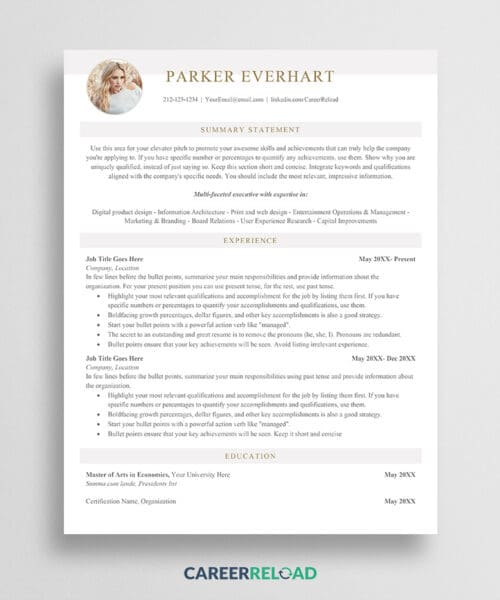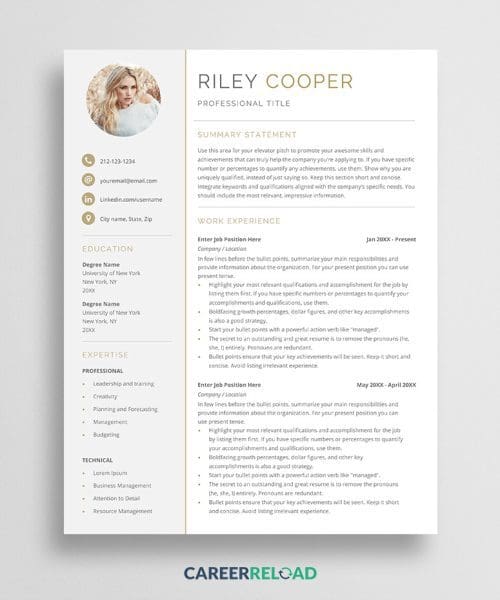How to Write a Resume
Ultimate resume writing guide
How to Write a Cover Letter
Step-by-step cover letter writing tips
- Free Personality Test
- Should You Quit Your Job Quiz
- Resume Quiz
- Side Hustle
- Search for:
- Build a Resume
Home » Career Advice » Resume Tips » How to List School Projects on Your Resume


How to List School Projects on Your Resume
I work with a lot of students and many feel as though they don’t have enough information or valuable information to put on their resumes. I promise, this isn’t true! In fact, if you don’t have work experience, you can still write a great resume based on your education and projects!
Headings for Students Resumes
The first realization students should come to is that there is no set way to write a resume. You do not have to have the same headings as everyone else! For students with no work experience, you do not have to have a “Work Experience” section on your resume. Perhaps you have volunteer experience. Title a section “Volunteer Experience” instead.
Additionally, many students have projects they have worked on during their education that are valuable and relevant to employers! I often suggest that students have a heading on their resume titled “Relevant Projects” or, say you are an engineering student, you can have a heading called “Engineering Projects.”
Consider these headings options for student resumes:
- Relevant Projects
- Work Experience
- Volunteer Experience
- Activities & Community Involvement
Including School Projects on Your Resume
If you choose to include school projects on your resume, and I hope you do, the next step is deciding what information to include.
First, you will want to make a list of relevant projects (both in-class and extra-curricular projects) that would be relevant and valuable to the position for which you are applying. The goal is to have three to five of your best and most relevant projects showcased in this section of your resume.
Next, take a close look at the position description. What skills, outcomes, and job duties compare and relate to the projects you have listed? It is important that the content on your resume relate to the job description. This will ensure your resume speaks to the needs of the employer. Additionally, it will help your resume pass an automated resume screening software should the company use one.
Finally, you want to make sure the information you include about each project provides tangible outcomes and illustrates the scope of the project. Employers want to know the outcomes of your work, and you can describe the outcomes of your project to help meet this need. Also, it is important that an employer know the scope of the project. How long and in-depth was each project you are listing? Provide information that helps them answer this question.
Example of Including School Projects on Your Resume
Now that you have a better idea of what to include in a projects section on your resume, let’s look at an example.
COMPUTER SCIENCE & CODING PROJECTS
- Swift Coding – Built and designed iPhone sports app allowing users to update sport scores, team standings, and player stats
- Python Bot Project – Developed, tested, debugged, and improved bots to complete automated tasks on Twitter and in Crypto markets
- Java App Project – collaborated with peers to architect an algorithm sorting application
In the example above, the student is now bringing education and training to life for a potential employer by illustrating how coursework has been used in practical, relevant projects. Had the student only listed education and coursework, employers would have much less perspective on what the student can produce (outcomes) and the scope of his coursework (how in-depth the content was).
Writing a Strong Student Resume
As you write your resume, remember to choose your headings based on the information that best highlights your education, skills, experience, and, very importantly, the needs of the employer. If you write a generic resume with the standard education, work experience, and general skills section, you might be missing a big opportunity to speak directly to the needs of employers and provide them with tangible evidence of your abilities!

Loren Kelly is a seasoned Career Coach for Students and a College Instructor. She is passionate about helping students prepare for a career while they are obtaining their education. If you need help determining a fulfilling career path or marketing yourself to employers through your resume, cover letter, or LinkedIn, be sure to take advantage of a free, 30-minute consultation with Loren!
Write a resume that lands more interviews!
Create a job-winning resume in 15 minutes with the help of a resume builder. Get a walkthrough of each section and fill out your resume within minutes.
Others also read

9 Tips to Improve Your Chances at Job Fairs

10 Tips to Ace Your Interview With a Temp Agency

Dental Assistant Resume Example That Work

6 Free Resume Review Services

From Drafting Résumés to Acing Interviews

How Technology Can Help with Your Job Search

The Interview Style Guide: 8 Rules to Follow

Tips for Choosing the Best Time to Resign from Your Job
You might also like these free templates.

Simple Resume Template with Photo – Parker

ATS Resume Template for Word – Jennifer

Download Free Word Resume Template – Riley

Free Resume Layout for Microsoft Word

Goal Planner

Cover Letter Template with Monogram

Professional Cover Letter Template

Free Modern Resume Template for Word
Free Job Application Tracker for Excel

Resume Checklist

Free Resume Template Download for Word – Farrah

Free Google Docs Resume Template Download – Will
- Resume Writing Guide
- Resume Tips
- Cover Letter Tips
- Job Interview Tips
- Professional Development
- Workplace Tips
- Leadership & Management
- Small Business & Side Hustle
- Word Resume Templates
- Google Docs Resume Templates
- Pages Resume Templates
- PowerPoint Resume Templates
- Photoshop Resume Templates
- Word Cover Letters
- Google Docs Cover Letter Templates
- Pages Cover Letter Templates
- PowerPoint Cover Letter Templates
- Photoshop Cover Letters
- Resume Examples
- Cover Letter Examples
- Resignation Letter Examples
- Recommendation Letter Examples
- Worksheets & Checklists
- Business Card Templates
- Personality Test
Username or email address *
Password *
Remember me Log in
Lost your password?
- Career Blog
Projects on Your Resume: Listing Work and Academic Projects

Including projects on your resume is a great way to highlight your skills and experience. This section will discuss the importance of highlighting projects and skills, the positive impact projects can have on job applications, and how to highlight individual work and team collaboration.
Importance of Highlighting Projects and Skills
When you include your project work on your resume, you are showcasing your ability to take initiative, work independently or collaboratively, and contribute to meaningful projects. Projects completed both in a work or academic setting can demonstrate your ability to solve problems, create solutions, and demonstrate your subject matter expertise.
Employers are looking for candidates who can make a positive impact on the organization, and projects provide evidence of your ability to do so. By highlighting projects and skills, you can show potential employers that you have a track record of delivering quality work and generating meaningful insights.
How Projects Can Positively Impact Job Applications
Including projects on your resume can help you stand out from other applicants. In particular, if you have completed projects that are relevant to the job you are applying for, you can demonstrate that you have the specific experience and knowledge needed to excel in that role.
Additionally, projects can also indicate your work ethic, attention to detail, and willingness to take on new challenges. All of these attributes are highly valued by employers, and highlighting them on your resume can make you a stronger candidate in the hiring process.
Highlighting Individual Work and Team Collaboration
When highlighting projects on your resume, it is important to provide details about your individual contributions as well as your team collaboration. This can involve listing specific tasks you completed, detailing any challenges you faced and how you overcame them, and highlighting any specific skills you developed as a result of the project.

You should also describe how you worked with others on the project, providing examples of how you contributed to the overall success of the team. This can include detailing your team leadership skills, your ability to collaborate effectively, and your willingness to take on additional responsibilities to ensure the project’s success.
Listing your projects on your resume can add significant value to your job applications. By showcasing your skills, experience, and ability to work both independently and as part of a team, you can demonstrate to potential employers that you are a strong candidate for the role.
Identifying Relevant Projects
When it comes to crafting a winning resume, including the right projects can make all the difference. But how do you know which ones deserve a spot on your CV? Here are some tips for identifying the most relevant projects to showcase your skills and impress potential employers.
Identifying the Right Projects for Inclusion in Your Resume
First things first, it’s important to know which projects to include on your resume. Not every project you’ve worked on may be relevant to the position you’re applying for. To determine which projects to include, ask yourself the following questions:
- Does this project align with the requirements of the job I’m applying for?
- Did I contribute significantly to the project’s success?
- Does this project showcase skills that are relevant to the job?
By answering these questions, you can narrow down the projects that are most relevant to the position and highlight your strengths.
Differentiating Between Work and Academic Projects
It’s also important to understand the differences between work and academic projects. Work projects typically involve real-world problems, specific goals, and deadlines, while academic projects focus on theoretical concepts and often have more open-ended outcomes.
When including academic projects on your resume, focus on the skills and knowledge gained rather than the project itself. For example, if you worked on a research project, emphasize the research skills and analytical abilities you gained rather than the particulars of the project.
Identifying the Most Impressive Projects
Finally, once you’ve narrowed down your project list, it’s time to identify the most impressive ones. These are the projects that demonstrate your expertise, creativity, and problem-solving abilities. To identify these projects, consider the following:
- Projects with notable outcomes or achievements
- Projects that required innovative solutions or unique approaches
- Projects with clear metrics that demonstrate success
By highlighting these impressive projects on your resume, you’ll be able to stand out from the competition and showcase your potential as an employee.
Identifying the most relevant projects to include on your resume requires careful consideration of the position, your skills, and the projects themselves. By following these tips, you’ll be able to craft a winning resume that showcases your achievements and makes you a top candidate for the job.
Types of Projects to Include on Resume
When listing projects on your resume, it’s important to understand the different types of projects that can be included. These include academic projects, work-related projects, and personal projects. In this section, we’ll discuss each type and how to select the most relevant projects for your career.
Understanding Different Types of Projects
Academic projects refer to projects completed during your studies. These can be individual or group projects and can include research papers, case studies, presentations, or capstone projects. Academic projects demonstrate your ability to apply the knowledge and skills you’ve gained in your studies to real-world problems.

Work-related projects include any projects completed during your employment, such as product launches, marketing campaigns, process improvements, or software development projects. Work-related projects demonstrate your ability to work in a team and deliver results in a professional setting.
Personal projects refer to projects you complete outside of work or school, such as volunteer work, blog writing, or creating a website. These projects demonstrate your personal interests and skills.
Selecting the Most Relevant Projects for Your Career
When selecting projects to include on your resume, it’s important to choose projects that are relevant to your career goals. For example, if you are applying for a job as a software developer, you should list work-related or academic projects related to software development or computer science.
It’s also important to choose projects that demonstrate your unique skills and strengths. For example, if you are an excellent communicator, you could include a project that required strong communication skills or involved leading a team.
Using Examples to Showcase Projects Effectively
When listing projects on your resume, make sure to provide specific examples of your accomplishments and contributions. For example, instead of simply stating that you worked on a team project, provide details on your role in the project and the results achieved.
Additionally, make sure to quantify your achievements whenever possible. For example, you could mention how the project you worked on resulted in increased sales, improved customer satisfaction, or cost savings for your company.
By understanding the different types of projects and selecting the most relevant ones for your career, you can effectively showcase your skills and accomplishments on your resume.
How to List Projects on Resume
When it comes to listing projects on your resume, proper formatting and clear organization are crucial. A well-structured project section can showcase the depth of your experience and expertise and help you stand out from other applicants. In this section, we will discuss the different sections to include and how to give enough details to showcase the depth of the project.
Proper Formatting and Organization
The first step in listing projects on your resume is to ensure proper formatting and organization. This includes using bullet points to make your information easy to read, using clear headings and sections to highlight different projects, and ensuring consistency in font and formatting.
When listing your projects, consider breaking them down into sub-headings, such as Work Projects, Academic Projects, or Volunteer Projects. This can help to give context to the reader and make it clear what type of experience you have in each area.
Explanation of the Different Sections to Include
The following sections should be included in your project section:
Project Title: This should be the name of the project you worked on.
Description: In a few sentences, describe the project, your role, and your contributions. Be sure to highlight the skills you used and the results you achieved.
Date: Include the month and year of your involvement in the project.
Skill Keywords: Include keywords that are relevant to the skills you utilized in the project. This can include technical skills, such as programming languages, or soft skills, such as communication or leadership.
Results and Achievements: Where possible, include specific results or achievements from the project. This could be a successful launch, a positive feedback from superiors or increased engagement numbers.
Giving Enough Details to Showcase the Depth of the Project
When listing your projects, be sure to give enough details to showcase the depth of your experience. This can include the size of the team you worked with, the budget of the project, and any challenges you faced and overcame. Additionally, highlighting the specific skills you utilized and the results you achieved can help to demonstrate your expertise.
However, be careful not to insert too much detail. As a rule of thumb, your project descriptions should be no more than 3-4 bullet points. Keep your information clear, concise, and relevant.
When listing projects on your resume, proper formatting and organization are key. Include the project title, description, date, skill keywords, and achievements. Be specific in the details provided, but avoid overloading with unnecessary information. With these tips, you can create a clear and concise project section that showcases your expertise and experience to potential employers.
Tips for Describing Projects on Resume
When it comes to showcasing your work and academic projects on your resume, clear and concise descriptions are key. Here are some tips to help you effectively describe your projects:
Writing Clear Descriptions
Make sure your descriptions are easy to understand and free of technical jargon. Use simple language to explain what the project entailed and what you achieved. Consider including the problem you solved, the approach you took, and the outcome of the project.
Defining Your Role within the Project
It’s important to clearly define your role within the project. Did you lead the project or were you a team member? What were your specific responsibilities? This will give potential employers a better understanding of your skills and expertise.
Showcasing the Size and Scope of a Project
Use numbers and data to showcase the size and scope of the project. This could include things like the budget, the number of people involved, or the timeline of the project. Also, consider including any awards or notable recognitions the project received.
When describing your projects on your resume, be sure to focus on the impact and results you achieved. By outlining your specific contributions and showcasing the size and scope of the project, you can make a strong case for your experience and expertise.
Example: Listing Work Projects
When it comes to showcasing your experience on a resume, listing your work projects can be an effective way to demonstrate your skills, responsibilities, and accomplishments. This section will provide examples of project descriptions that can help you tailor your own resume to highlight your unique experience.
Each example project description should focus on the core skills you utilized during the project, the responsibilities you had, and any achievements or accomplishments that resulted from your work. By demonstrating your value through these descriptions, you can effectively communicate your potential to future employers.
Including relevant work projects on your resume can also help you stand out from other candidates. In today’s competitive job market, it’s important to show that you have real-world experience and have successfully tackled complex tasks related to your job or industry. Listing specific projects shows that you have a deep understanding of your current role and the skills necessary to excel in it.
When selecting which projects to include on your resume, consider the significance of each project. Did it have a measurable impact on your company, industry, or community? Did you play a key role in the project’s success? If so, be sure to highlight your contribution and the results of your efforts.
Including work projects on your resume can give you a significant edge over other candidates. By showcasing your skills, responsibilities, and accomplishments, you demonstrate that you are a valuable asset to any organization. So, take the time to carefully select and highlight your most important projects and watch as potential employers take notice of your experience and potential.
Example: Listing Academic Projects
This section is dedicated to showcasing examples of academic project descriptions that effectively highlight skills, knowledge, and academic accomplishments.
When it comes to crafting a compelling resume, it’s important to include relevant projects that showcase your abilities and achievements. Academic projects offer a unique opportunity to showcase your expertise in a particular area and demonstrate your commitment to your field of study.
Academic projects can range from research papers and case studies to group projects and presentations. When listing these projects on your resume, it’s important to highlight the skills and knowledge that you gained while completing them. This could include things like critical thinking, problem-solving, research, writing, presentation, and teamwork skills.
Including academic projects on your resume can also demonstrate your commitment to your field of study and your desire to continue learning and growing in your profession. It can show potential employers that you are dedicated to your craft and that you have a deep understanding of the subject matter.
Including academic projects on your resume can help you stand out from other candidates and demonstrate your skills, knowledge, and commitment to your field. When listing your academic projects, be sure to focus on the skills and knowledge that you gained from them and explain how they are relevant to the position or field that you’re applying to.
Including Non-Project Experience
When it comes to listing projects on your resume, it’s important to understand how to balance non-project experience with project experience. Non-project experience can include part-time jobs, internships, volunteer work, extracurricular activities, and personal projects.
While project experience can demonstrate your skills in a specific field, non-project experience can showcase your transferable skills, such as communication, leadership, problem-solving, and teamwork.
To highlight your transferable skills, it’s essential to provide a brief description of your non-project experience on your resume. For example, instead of simply writing “Cashier at ABC Store,” you could write “Provided excellent customer service, handled cash and credit card transactions, and trained new employees.” This way, you’re not just listing your job title, you’re demonstrating the skills you gained from the job.
Another way to use non-project experience on your resume is to support your project descriptions. For example, if you completed a project that required you to work with a team, you could mention your experience as a team captain in your college club. Or, if you developed a website for a project, you could mention your experience in freelance web design.
Including non-project experience on your resume can be advantageous in showcasing your transferable skills and supporting your project descriptions. Remember to balance your non-project and project experience appropriately and demonstrate the skills you gained from each experience.
Common Resume Mistakes to Avoid
When it comes to your resume, showcasing your projects can be a great way to highlight your skills and experience. However, there are some common mistakes to avoid when listing your projects. Here are some tips to help you avoid pitfalls and strengthen your project descriptions:
Discussion of common mistakes when listing projects
Failing to provide context: When listing your projects, it’s important to provide context for each one. This includes explaining your role in the project, the goals and objectives, and the outcomes achieved. Without this information, your project descriptions may be unclear and unimpressive.
Being too vague: Don’t be afraid to get into the details of your projects. Give concrete examples of the work you did and the impact it had. Vague project descriptions can be a turn-off for potential employers.
Focusing only on technical skills: While technical skills are important, remember that your projects also demonstrate your teamwork, communication, and problem-solving abilities. Make sure your descriptions highlight these important soft skills as well.
Avoiding common traps and pitfalls
Listing irrelevant projects: When deciding which projects to include on your resume, make sure they are relevant to the job you are applying for. Listing too many or irrelevant projects can be overwhelming for the reader and detract from your more important experiences.
Only including completed projects: If you have projects that are still in progress, don’t be afraid to list them. Showcasing your ability to manage ongoing projects can be an impressive quality to potential employers.
Not showcasing your unique contributions: Make sure your project descriptions highlight your specific contributions and achievements. This can help differentiate you from other candidates with similar project experience.
Pointers for strengthening your project descriptions
Use action verbs: Start your project descriptions with strong action verbs to emphasize your accomplishments. Words like “managed,” “developed,” and “implemented” can convey a sense of leadership and accomplishment.
Quantify your results: Whenever possible, include specific metrics to quantify the results of your projects. This can help demonstrate the impact of your work in a concrete way.
Keep it concise: While it’s important to provide details about your projects, make sure your descriptions are still concise and easy to read. Stick to the most important information and avoid rambling or unnecessary details.
By avoiding common resume mistakes and strengthening your project descriptions, you can make your resume an impressive representation of your experience and skills. Use these tips to showcase your project work and stand out from other candidates.
Related Articles
- 25 Restaurant Manager Resume Examples with Helpful Tips
- Quality Manager Resume: Examples and Writing Guide
- Hotel Receptionist: Job Description, Salary, and Skills
- Create Your Own Resume: A Complete Guide for 2023
- 20 Effective Techniques for Motivating Your Team in 2023
Rate this article
0 / 5. Reviews: 0

More from ResumeHead

How to List Projects on a Resume: A Concise Approach
In This Guide:
What are the benefits of listing projects on a resume, types of projects to include on your resume, how to list projects on a resume, how to avoid sounding boastful, how can i talk about a confidential project on a resume, how many projects should i include in a resume, summary & key takeaways: how to list projects on your resume.

You want to list projects on your resume, but you’ve got no idea how to do it?
Keep reading and you will learn:
- What are the benefits of listing projects on your resume
- What types of projects should you include on your resume
- How to list projects on your resume
- How to avoid sounding boastful
- How to talk about a confidential project on your resume
- How many projects should you include on your resume
If you want to save some time, you should definitely check out our Resume Builder .
But if you really want to really dig into the issue of listing projects on your resume, just keep reading.
Let’s dive in.
Why should I include projects on my resume, how would that help me?
The main goal of listing projects on your resume is to show potential employers that you have gained skills, experience and professional achievements that fit perfectly into their role.
What is important to do when listing your projects, is to highlight hands-on examples of how you applied your capabilities to find solutions.
Describing your experiences in the projects can also show potential employers if your character would be compatible with the company.
What is more, you can use these highlights to show that you have leadership skills, project management expertise and the ability to take initiative.
If you play your cards right, potential employers will start to picture you in a position that requires you to use the skill set you have gained in your previous projects.
There are a few types of projects you can include on your resume.
Keep in mind that whatever project you list, should apply to the job you are applying for. Its purpose is to increase your chances, so choose wisely.
We are going to take a look at the three most common types of projects that you can list on your resume:
Work projects
Your relevant work experience always works in your favour.
The way you can strengthen its effect and catch the recruiter’s eye is to list projects from your previous places of work on your resume.
Keep in mind that you should only highlight projects and accomplishments that show a set of skills relevant to the position you are applying for.
Personal projects
Another way to go is to list personal projects that show skills and personality traits that your potential employer might be looking for.
The project can be anything from community service and volunteering, to a personal project such as a blog.
Personal projects can make a really powerful impression on potential employers. They show that you take personal initiatives that develop your skills and personality traits.
When you have little or no work experience, personal projects can make an excelent addition to your resume.
Academic projects
The third main project type you can include in your resume are academic projects.
These projects can greatly highlight the skills and competencies relevant to a position you are applying for.
Academic projects can show your technical expertise or demonstrate soft skills such as teamwork and leadership.
Don’t hesitate to include any of these three types of projects on your resume. They can only work in your favour.
When listing projects on your resume, your best choice would be to write them below a job description as accomplishments.
Another way to go is to list them in a separate section. You can name it Projects, Academic Projects or Personal Projects, depending on their type.
If your projects are Academic, it’s better to list them in the education section on your resume.
If your projects are the strongest thing in your resume, we advise you to create a project-based resume.
Let’s take a look at all these scenarios.
Project-Based Resumes for Freelancers
When you are a freelancer, you will need a slightly different approach to building your resume.
A reverse chronological format works perfectly for most resumes.
It makes your resume easy to read by recruiters and it shows them if your experience is relevant in no time.
But when you are building a project-based resume, this format will probably not work so well.
As a freelancer, you probably work on lots of projects, and in many cases, the last one in reverse chronological order would not be suitable for the position you are applying for.
The actual problem arises because of the fact that recruiters have to look through lots of resumes every day.
That’s why a recruiter only spends about 7 seconds on a single resume, so chances are that a freelancer with a standard reverse chronological format resume would not be noticed.
The best way around that is to remove your work experience section, and replace it with Projects section.
Make sure you include details for every project in the section. That includes an overview of the project, time and numerical results/achievements.
Here is an awesome example of what you need to do for every project on your resume:


Adding Projects to a Resume—Traditional Employment
Even if you are not a freelancer, you might feel like you should include some of your side projects.
Don’t hesitate, but list them.
Projects are a great addition to traditional employment types of resumes as well.
What you need to do if you have extensive experience, is to create a separate section for your projects only.
Recruiters love extra sections. Having an extra section for your projects can only work in your favour.
As projects are not the main strength of your resume, you need to keep the project description brief.
Here is one example to get you going:
Key Projects
Spearheaded a cost-cutting project achieving a $50,000 dollar annual saving by replacing paper towels with hand dryers in all bathroom facilities as National Operations Manager with Redbridge Systems.
Adding School, College and Academic Projects to Your Education Section
If you recently graduated high school or college, or you are still studying, you might find it difficult to write your resume.
What you can do in this situation is list School, College and Academic Projects on your resume.
By shifting the focus from the lack of work experience to the projects and the skills you have gained from them, you can easily get some bonus points with the recruiter.
Here is an example of how to include project, such as volunteer work, on your resume:

There is also a slight risk, that listing projects on your resume might sound rather boastful.
In order to avoid that moment, you might want to stick to the advice of keeping it simple.
What you need to mention is an overview of the project, time and numerical results/achievements.
When you are using a confidential project on your resume to land a new job, caution is advisable.
It’s one thing to list a project on your resume when it has already gone public, but mentioning a confidential project is a good way to wreck your chances of getting the job.
Keep in mind that no employer wants an employee who would be willing to share a confidential project on a document that any stranger could potentially see.
You might think that you would be safe if you leave out most of the information.
However, the truth is that the recruiter may feel like it would be right to call your former employer and tell them that you are leaking confidential information.
Your week would probably not improve from there on, especially if you have a confidentiality agreement signed in the past.
So, all in all, you should focus on your public projects and accomplishments. Doing so will make your life much less complicated.
You should consider including a link to your online portfolio, website or blog if you have any.
This would encourage the hiring manager to review your projects in greater detail, and allow them to see the skill set you have acquired while working on the projects.
You should also focus on the projects that present your skill set in the best light,
What you need to do is list only a few important projects on your resume. If you have more to show the potential employer, you should definitely include a professional portfolio.
So, all in all, in most cases it is a good idea to include projects on your resume.
No matter if your projects come from former work, high school, college, or if they are personal, they can only work in your favour.
The key points you need to take out at the end of the day are:
- If you are a freelancer, you might want to consider building a project-based resume, instead of using a reverse-chronological format
- If you have some additional projects to your work experience, you should include them in your Work Experience or Education sections. If you have more projects, consider creating a separate section for your projects only.
- If you have too many projects you want to mention on your resume, consider mentioning the most important ones and include a link to a professional portfolio
- If you have worked on a confidential project, better leave it out of your resume
So, there you go, you are ready to get your resume to the next step.
Include the projects you have worked on and get the interview for your dream job.
*** What are your thoughts? Did you list your projects on your resume? Give us a shout out in the comments below. We’d love to hear from you!

- Resume Guides
What Are The Four Parts Of A Cover Letter
How to answer the “what makes you unique” interview question (with tips and examples), what should i put in the about me section on my resume, how do i make a professional resume, create a resume from linkedin, how to answer "why should we hire you".
- Create Resume
- Terms of Service
- Privacy Policy
- Cookie Preferences
- Resume Examples
- Resume Templates
- AI Resume Builder
- Resume Summary Generator
- Resume Formats
- Resume Checker
- Resume Skills
- How to Write a Resume
- Modern Resume Templates
- Simple Resume Templates
- Cover Letter Builder
- Cover Letter Examples
- Cover Letter Templates
- Cover Letter Formats
- How to Write a Cover Letter
- Cover Letter Guides
- Job Interview Guides
- Job Interview Questions
- Career Resources
- Meet our customers
- Career resources
- English (UK)
- French (FR)
- German (DE)
- Spanish (ES)
- Swedish (SE)
© 2024 . All rights reserved.
Made with love by people who care.
Explore Jobs
- Jobs Near Me
- Remote Jobs
- Full Time Jobs
- Part Time Jobs
- Entry Level Jobs
- Work From Home Jobs
Find Specific Jobs
- $15 Per Hour Jobs
- $20 Per Hour Jobs
- Hiring Immediately Jobs
- High School Jobs
- H1b Visa Jobs
Explore Careers
- Business And Financial
- Architecture And Engineering
- Computer And Mathematical
Explore Professions
- What They Do
- Certifications
- Demographics
Best Companies
- Health Care
- Fortune 500
Explore Companies
- CEO And Executies
- Resume Builder
- Career Advice
- Explore Majors
- Questions And Answers
- Interview Questions
How To Put Projects On A Resume (With Examples)
- Resume Tips
- Best Resume Writing Services
- Things To Avoid On A Resume
- Resume Paper To Use
- What To Include In A Resume
- How To Write A Bio
- How To Write A Personal Statement
- Lied on Your Resume?
- Avoid Age Discrimination
- Words and Phrases You Shouldn't Include in Your Resume
- How Many Skills Should You List On A Resume
- Send A Resume As A Pdf
- Resume Critique
- Make A Resume Stand Out
- Resume Spelling
- Resume Past Or Present Tense
- How To List Projects On A resume
- Best Resume Action Words
- How To Quantify Your Resume
- Resume Bullet Points
- Are Resume Writers Worth It
- How Many Jobs To List On Resume
Summary. To put projects on your traditional chronological resume , include a separate projects section beneath the education or work experience section. In a project based resume, rename the work experience section to be named “projects” and you can avoid the standard chronological resume format and instead focus on your most relevant projects and professional skills.
No matter where you are in your career journey, adding projects to your resume can highlight your key qualifications and help your application make more of an impression.
In this article, you’ll learn how to add projects to your resume and when it’s a good idea to take this route.
Key Takeaways
You can work projects into your work history section, organize your resume around your projects, or create a separate section for your projects.
You should list your most relevant projects first and leave off any irrelevant projects.
Freelancers, entry-level job candidates, and people who are changing career paths could benefit most from project-based resumes.

How to List Projects on a Resume
Examples of ways to list projects on a resume, tips for listing projects on a resume, why should you put projects on a resume, what is a project-based resume, who should use project-based resumes, putting projects on a resume faq, final thoughts.
- Sign Up For More Advice and Jobs
To list projects on a traditional chronological resume , you should include a separate projects section beneath the education or work experience portion of your professional resume. This can be easily accomplished by including a “key projects” section below the bullets detailing your previous job responsibilities and accomplishments.
Listing projects on a traditional date-ordered resume can be a great option for professionals who want to showcase their project management expertise while also detailing their prior work titles and chronological job experience.
If you’re looking to ditch your traditional chronological resume altogether, a project-based resume is a great way of showcasing your most desirable professional skills outside of the tight confines of a standard cookie-cutter resume that lists your work experience in reverse chronological order.
By renaming the “work experience” section of your resume to “projects,” you can easily avoid the standard chronological resume format and instead focus on your most relevant projects and professional skills. This unique structure focuses more on practical, hands-on experience and less on how long you held a certain job title.
To list projects on a resume:
Contextualize the project’s details. You don’t want each project to take up too much space, but you do need to describe the key who, what, where, when, and why of the story. Most importantly, bring in numbers as often as possible.
Highlight your accomplishments. “Ideally, your resume is a list of achievements,” says resume expert Don Pippin . When describing your projects, be sure that the direct impact that you had on the end result is apparent.
Tailor your resume for each job. Again, this applies to all resumes, not just project-based ones. In the context of projects, though, be sure to think about how each entry relates to the specific job you’re applying for.
Provide examples. If you’re emailing your resume, including some hyperlinks to documents relating to past projects can be really impactful. Not only can the hiring manager see the results of your work, but also how you and your team approached projects in general.
Below are three examples of ways you can list projects on your professional resume or CV . Using these examples as a template when writing your job-specific resume can help you advance in the hiring process and land the job of your dreams.
Listing Projects in the Education Section of Your Chronological Resume Example:
Education Massachusetts Institute of Technology | Cambridge, Massachusetts B.S. in Mechanical Engineering , May 2020 | GPA: 3.8 Key Projects: Led a team of three engineering students to execute blueprints and coordinate the production of state-of-the-art air filtration systems for the university hospital. Production and installation came in 12% under budget and were completed 2 weeks ahead of schedule.
Listing Projects Below Previous Job Responsibilities and Work Descriptions in Your Chronological Resume Example:
Work Experience Sales Associate Baker Technologies | March 2019-present Drove revenue by 13% year-over-year by initiating increased customer engagement policy Oversaw a team of five cashiers, who collectively processed average credit card and cash payments of over $20,000 daily Key Projects: Worked with a software developer to redesign and launch Baker Technologies’ online marketplace, resulting in a $2 million increase in profits for 2019.
Listing Projects in a Projects Section of Your Project-Based Resume Example:
Professional Project Highlights App Development Camping With Oliver , July 2020-November 2020 Developed and coded a complex app, compatible with iPhone and Android devices, designed to help hikers locate free campsites in their area. Increased digital revenue stream by 55% following launch Private Web Design Bobbi’s Bakery , January 2021-March 2021 Built a multifunctional website with a complex ordering system using HTLM 5, CSS, and bug-free code Managed all custom graphics, page composition, and branding for this client, leading to a 30% Q/Q jump in sales
If it’s your first time listing projects on a resume or ditching your traditional chronological resume or project-based one, there are a few things you need to keep in mind to craft an effective resume and impress hiring managers.
By following these five tips, you’ll be able to perfectly listing projects on your professional resume and allow your key skills and job qualifications to shine.
Lead with the most relevant projects. One of the biggest advantages of a project-based resume is having the ability to list your work experiences and skills in order of the most relevant projects, instead of arranging them chronologically.
Highlight leadership and job-specific skills. If you’re listing projects on your resume, it’s important to be deliberate and meticulous in the projects you include. Your project list should be presentable, professional, and perfectly convey your leadership and job-specific skills.
Show how you achieve results and meet company goals. Another substantial perk of listing projects on your resume is the ability to clearly illustrate and verify how you are results-driven and ready to meet company goals.
Illustrate how your experiences align with company values. Not only is it important to showcase the skills and qualifications required for a job opening, but it’s also essential to illustrate how your work style and professional goals align with the values a company prides itself on.
Keep project descriptions short. To emphasize your strongest skills and professional abilities, it’s important to keep project descriptions short, concise, and to the point. Providing only the essential details to demonstrate your skills, achievements, and experience will allow hiring managers to easily read and review your resume.
Listing projects on your resume will help you get a leg up over other qualified competing applicants.
A project-based resume, similar to a functional resume , is highly effective in conveying your unique qualifications, work style, field of specialization, and areas of expertise.
Project-based resumes are great tools for illustrating hands-on experience and your decision-making and conflict resolution skills. Describing projects you’ve been involved with can give hiring managers a glimpse into how you operate as an employee.
Submitting a project-based resume with your job applications can allow you to position yourself as the best candidate for the role by highlighting and describing projects that closely align with the job description included in the advertisement.
Including a list of projects on your resume will allow your job application to shine and illustrate your work capabilities and well-rounded personality; to hiring managers and job recruiters.
A project-based resume is a professional resume that focuses on accomplishments rather than chronological job titles and previous work responsibilities.
Where a traditional resume lists work experience and academic degrees in date order, a project-based resume instead does one of two things.
It either lists a job seeker’s relevant academic, work, and personal projects in order of most to least compelling or includes specific projects beneath the education or work experience sections of a resume.
Project-based resumes effectively provide hiring managers and prospective employers with verifiable proof of a job applicant’s industry expertise, achievements, and experience.
Anyone can use project-based resumes, but the following groups might find additional benefit:
Freelancers. Project-based resumes can be an especially worthwhile option for freelancers , as it allows you to ditch the traditional chronological resume and instead focus on projects you have worked on that are most relevant to the position you’re applying to.
Entry-level candidates. Not only is a project-based resume a great alternative for freelance workers, but it can also be equally as enticing for traditional employees or recent graduates since projects can be easily listed beneath education and work experience sections, as you would normally list accomplishments, skills, and previous job responsibilities.
Career changers. Writing a project-based resume can be a great option for people looking for their first job, changing careers, coming off a long sabbatical or personal leave, or searching for a full-time job after a series of freelance gigs.
Should I put my projects on my resume?
Yes, you should put your projects on your resume. Listing a few of your most impressive professional projects on your resume can help hiring managers see what you’re capable of.
What kind of projects should I put on my resume?
You should put successful, professional projects that relate to the job you’re applying for on your resume. Think of a few of the projects that demonstrate the skills that are listed on the job description you’re applying for and put them on your resume.
Do personal projects count as experience?
No, personal projects don’t count as experience. They don’t usually count as formal work experience, but that doesn’t mean you shouldn’t put some of them on your resume, especially if they demonstrate your professional skills.
is it OK to put project details in a resume?
Yes, It’s OK to put project details in a resume. Projects are a great addition to your resume when your experience section doesn’t already show that you have the background or experience for a job. Recent graduates or entry-level candidates are the ones who typically put projects on their resume.
Whether you’re a freelancer or a traditional employee, a recent graduate or a career changer, projects can make your resume pop.
By illustrating your hands-on work experience, verifying your skills and job qualifications, and marketing yourself as the best candidate for the role, you’ll have hiring managers who can’t wait to call you in for an interview to learn more.
Using the tips and templates included in this article can help you write a well-structured and effective project-based resume and make a great first impression on recruiters across industries.
Yale Law School – Resume Advice & Samples
How useful was this post?
Click on a star to rate it!
Average rating / 5. Vote count:
No votes so far! Be the first to rate this post.

Elsie is an experienced writer, reporter, and content creator. As a leader in her field, Elsie is best known for her work as a Reporter for The Southampton Press, but she can also be credited with contributions to Long Island Pulse Magazine and Hamptons Online. She holds a Bachelor of Arts degree in journalism from Stony Brook University and currently resides in Franklin, Tennessee.
Recent Job Searches
- Registered Nurse Jobs Resume Location
- Truck Driver Jobs Resume Location
- Call Center Representative Jobs Resume Location
- Customer Service Representative Jobs Resume
- Delivery Driver Jobs Resume Location
- Warehouse Worker Jobs Resume Location
- Account Executive Jobs Resume Location
- Sales Associate Jobs Resume Location
- Licensed Practical Nurse Jobs Resume Location
- Company Driver Jobs Resume
Related posts

Should A Resume Be Past Or Present Tense?

How To Put Stay-At-Home Mom Or Dad On Your Resume (With Examples)

How To Make A Resume In Word (With Examples)

Should A Resume Tense Be Past Or Present?
- Career Advice >
- Projects On Resume
- Majors, Careers, and Interests
- Job & Salary Trend Data
- Virtual Job Simulation Projects
- Resumes and Cover Letters
- For Interviews
- Career Events
- Internships
- Graduate/Professional School
- Faculty & Staff
- Career Champions
How—and When—to Include Projects on Your Resume (Plus Examples!)
- Share This: Share How—and When—to Include Projects on Your Resume (Plus Examples!) on Facebook Share How—and When—to Include Projects on Your Resume (Plus Examples!) on LinkedIn Share How—and When—to Include Projects on Your Resume (Plus Examples!) on X
How—and When—to Include Projects on Your Resume (Plus Examples!) was originally published on The Muse , a great place to research companies and careers. Click here to search for great jobs and companies near you.
If you’ve completed a project you’re especially proud of, it’s natural to want to show it off on your resume—and it might even help you land your next job. Projects that potentially belong on your resume can come from your past jobs, paid and unpaid side ventures, and—if you’re a recent grad—your academic coursework.
Read on to see why, when, and how you should put projects on your resume.
Why You Should List Projects on a Resume
Like everything else on your resume, projects can help highlight experiences that qualify you for your next job. You may have used skills— hard or soft —in a certain project that are key for the role you want. And including a successful project is a great way to tie those skills directly to results, which employers want to see on every resume.
When You Should List Projects on Your Resume
Adding projects to your resume “can be a great way to highlight experience outside of your daily role, enhance a recent grad resume, or bridge the gap from what you’re doing to what you want to do” if you’re looking to change or pivot careers, says Muse career coach Tara Goodfellow , owner of Athena Consultants .
Projects are an especially helpful addition to your resume when your experience section doesn’t already show that you have the background you need to get the job you want next, which is most common for two groups of job seekers:
- Recent graduates : Entry-level candidates by definition lack professional experience. But if you just finished college, a big project—whether you did it for a class, an honors or capstone program, an internship, or your own research—can show that you have a lot of valuable workplace skills such as leadership, collaboration, presentation, and public speaking, Goodfellow says. After your first-full time role, Goodfellow recommends removing school projects from your resume.
- Career changers or pivoters: When you’re looking to switch or pivot your career, you want to show any experience you have that relates to the role, field, or industry you want to go into. This might mean highlighting projects you did within a current or past job or adding a volunteer, side, or freelance project to your resume. What matters is that your project helps prove to employers you have relevant experience for the job you’re hoping to land.
Which Projects You Should Include
When you’re deciding which projects to add to your resume, “you want to be strategic,” Goodfellow says. “Don’t just dump every project you’ve been part of hoping something will catch the hiring manager’s attention.” Instead, carefully go over the job description for any role you’re interested in. Highlight any skills or qualifications the company is looking for that you have, as well as any job duties they list for the role that you’ve performed in the past. Then note any that can only be proven by including a certain project on your resume. If a project doesn’t meet this threshold, it probably doesn’t need to be called out.
Even if you’re in a more project-based field, like engineering, IT, or consulting, consider whether all or any of your projects can emphasize your accomplishments in a way that general bullet points under each job entry can’t. With too many projects crowding your resume, recruiters might not find the most important details. For example, if you generally do consulting for larger clients, but once worked with a small business and got great results, listing details for that one project might help you land a job at a consultancy with a small-business focus. But if most of your clients are small businesses, mentioning a slew of individual projects rather than overall achievements will take up valuable resume space without necessarily adding to your qualifications.
How to List Projects (Plus Examples)
List your projects wherever they’re most relevant, Goodfellow says. For recent grads, this often means your education section. If the project was part of a past job, freelance work, or volunteer work, it likely belongs under that specific entry in your experience section . If you’re thinking of a personal or side project or you have multiple projects that you want to include on your resume, you might consider adding a dedicated “Related Projects” or similarly titled section.
Regardless of where you list your project, you should follow these general tips:
- Include important details. You should add enough information about each project that it can be easily understood by anyone who reads your resume. Depending on the specific project, consider listing a project title, a project description, and project dates, as well as who you did the project for and with, what your role was, and what the results and impact were.
- Focus on your achievements. Whether your project description is contained to one bullet point or has several bullet points underneath it, employers want to see what results you’ve gotten with your skills so they can see how you might drive results for them. Use achievement-oriented , quantified bullet points to really put your accomplishments front and center.
- Tailor your project description for every job application. You should only include projects that are relevant to the specific job you’re applying for and, even more than that, you should make sure your description of a project highlights the pieces of it that are most relevant. So if a company is looking for someone with website design experience, focus on the design aspect of your side project, not how you attracted customers to your site. And try to use the same language and keywords as the job description.
- Include links to your work when possible. Almost everyone who reads your resume will do so for the first time on a computer, so links to work that’s live online are fair game. Just make sure you hyperlink an unimportant word like “Project” or even “Link” to avoid any applicant tracking system (ATS) issues.
What does this all look like in practice? Here are a few examples based on where you’re listing a project.
In an Education Section (good for a senior capstone)
This is how an entry-level applicant looking to emphasize their research, writing, and presentation skills might include a capstone project on their resume.
Bachelor of Arts in English | Colgate University | Hamilton, NY Expected Graduation: May 2022 Capstone Project: “Voices Missing From the 19th-Century Literary Canon”
- Wrote a 40-page dissertation on three minority writers who are not commonly taught in U.S. K-12 schools or colleges, exploring literary devices and techniques used before other writers who are commonly taught
- Presented research findings at Nineteenth-Century Studies Association 2021 Conference as one of five undergrads selected to give a 10-minute talk
- Researched writers’ lives and work by analyzing newspaper archives (via LexisNexis), conducting interviews with literary scholars who focus on the 19th century, and traveling to review old correspondence and writings not widely reproduced
- Analyzed 12 total texts to compare literary devices and techniques between focal writers and their contemporaries
Within a Dedicated Section (typical for current students and new graduates)
Here’s how an aspiring software engineer might describe a project they did in their free time to show off their coding chops to prospective employers.
RELEVANT PROJECTS
TheTradingPost.com | March 2020–September 2020 | Link
- Designed and coded a website (using CSS, Python, and JavaScript) where players of popular video games could arrange trades for virtual items, receiving an average of 1000 hits monthly
- Responded to user feedback and issues to improve site functionality and build additional features including a search function
Within Your Experience Section
Here’s how a marketer looking to pivot into project management might include a project under a past job immediately after the bullet points describing their overall duties and accomplishments.
Key Project
- Led $200k digital marketing campaign from conception to launch, resulting in 120% of target signups in first two months of campaign
- Managed cross-functional team of seven marketing coordinators and analysts, content creators, and designers through market research, content creation, campaign launch, and analysis of results, setting deadlines, adjusting to changes in schedule, and resolving conflicts and miscommunications among teams
Projects In Resumes: Where Do They Belong? (And How to Make Them Shine)

3 key takeaways
- Why including projects in resume sections is important
- How to use the Teal AI Resume Builder to list projects on a resume
- Inspirational examples of projects on a resume across a variety of professional scenarios
They highlight your skills, showcase your impact, and elevate your professional profile. But where do you include projects in a resume to have the most impact in a way that differentiates you and impresses prospective employers?
Whether you're a freelancer with a diverse portfolio , a professional aiming to showcase your accomplishments, a recent graduate with academic projects, or someone looking to make a career change, effectively showcasing your project experience can distinguish you in a way that helps drive your career.
Why including projects on your resume can make a difference
Including relevant projects on your resume can significantly impact how hiring managers or recruiters view your qualifications. If you're wondering how to write experience on a resume , projects are a fantastic way showcase your skills, creativity, initiative, and problem-solving abilities. And they offer tangible evidence of everything you're capable of while adding depth to your resume beyond traditional work or educational experience.
What kinds of projects should you put on a resume?
- Academic projects demonstrate your ability to apply theoretical knowledge to practical situations.
- Personal projects reflect your passion, self-motivation, and dedication.
- Team projects highlight your collaboration, communication, and teamwork skills.
- Freelance projects reveal your entrepreneurial spirit, client management skills, and ability to deliver results independently.
- Volunteer projects emphasize your commitment to community service, teamwork, and social causes.
- Leadership projects reveal your ability to take charge, inspire others, and drive successful outcomes.
And while most projects contribute to growth through the lessons or skills you’ve learned, the key to including projects in a resume is choosing ones relevant to the job description or industry you're targeting.
Choosing the right projects ensures that those you list resonate with the hiring manager, showcasing your expertise in a way that directly relates to the position you're applying for.
When should you include projects on your resume?
Deciding whether to include projects on your resume largely depends on your professional circumstances and the specific job you're applying for.
So, which professional scenarios would benefit from the impact projects offer?
When you're a freelancer or contract worker
Projects are often a primary form of work for freelancers or contractors. And, if you’ve found yourself in this professional realm, you should prominently showcase them as resume accomplishments within your “Work Experience” section. Think of creating your work experience as a more project-based resume section instead. (Just remember to be mindful of any non-disclosure agreements you may have signed before listing any client-identifying information.)
For example, imagine you're a freelance web designer who completed a website revamp for a client in coffee distribution. In this case, you didn't sign a non-disclosure agreement, so you're free to use their name, metrics, and more. Here's how you would highlight the project on your resume:
Website Redesign: Bigbie Coffee
- Created visually appealing and user-friendly website interface featuring responsive design, intuitive navigation, and enhanced branding.
- Received positive client feedback on new website's aesthetics, functionality, and improved user experience.
- Resulted in a 30% increase in website traffic within the first month of the redesign implementation
- Redesign resulted in a 20% increase in online orders and a 15% rise in average transaction value.
When you're a student or recent graduate
Especially if you're a student or recent graduate creating a resume with limited professional experience, showcasing academic projects in a resume can serve as valuable evidence of your skills, knowledge, and initiative—positioning you as a qualified and capable candidate.
For instance, if you've recently graduated college with a Bachelor's Degree in Computer Science, a resume project could look like this:
Senior CS-450 Software Development Project
- Developed a comprehensive task management application utilizing Java and JavaScript, allowing users to create, assign, and track tasks, set deadlines, and collaborate with team members seamlessly.
- Received an outstanding grade of 99% for the project—showcasing excellence in software design, implementation, and functionality.
- Received positive feedback from both professors and classmates on the application's intuitive user interface, robust functionality, and efficient task management capabilities.
When you're changing careers
Transferable skills are the bread and butter of any career changer's resume. They highlight valuable abilities, demonstrate soft skills, and convey knowledge you've acquired that applies to other careers, industries, or professional spaces.
As a career changer, key projects demonstrate transferable skills and showcase your passion and knowledge for the target industry or field you are transitioning into.
Let's say you're shifting from financial services to sales. In that case, showcasing a leadership project, like spearheading a cross-functional team to implement a CRM system that resulted in improved sales processes, streamlined communication, and increased client retention rates, would be applicable. This is because the leadership skills, communication, and problem-solving skills demonstrated in this project are highly transferable to sales.
So how could that look as a project in a resume?
CRM Implementation for Enhanced Sales Processes and Client Retention
- Led a team of 10 in successfully implementing a CRM system within the financial services department.
- Facilitated cross-functional collaboration between sales, marketing, and IT teams, ensuring smooth adoption and integration within seven business days.
- CRM implementation resulted in a 25% improvement in efficiency, reduced manual effort, and enabled teams to focus on client interactions, leading to a 15% increase in client retention rates within six months.
When you don’t have much relevant work experience
If you're trying to create a resume with no work experience or have minimal relevant experience, personal projects can help demonstrate ability, initiative, and dedication.
Imagine you've been out of the workforce for some time. What personal projects might be relevant if you're applying for a job role in software marketing? Volunteering for a school PTO, organizing a fundraising campaign, maintaining a personal blog or website, or creating social media campaigns for various causes are all valuable and relevant in marketing.
So how can you add one of those examples as a project description in a resume?
Culinary Lifestyle Blog: Gourmet Delights
- Successfully maintained and curated a culinary lifestyle blog, "Gourmet Delights," for four years, focusing on exploring unique flavors, recipes, and culinary experiences.
- Increased website traffic year over year, achieving a remarkable 200x growth in monthly page views and engagement YoY through effective content creation and promotion strategies.
- Recognized for consistent updating and high-quality content, leading to partnerships with renowned brands and selection for paid advertisements, establishing the blog as a trusted resource within the culinary community.
When you’re applying for project-based roles
If you're applying for a project-based role such as project manager, coordinator, or administrator, showcasing the skills you've developed by completing various projects demonstrates competence and experience.
As a resume project, this could look something like the following:
Software Implementation - StreamlineX
- Led the successful implementation of the StreamlineX software solution, overseeing a team of 10 developers, coordinating activities, and ensuring timely delivery.
- Met all project deadlines with 100% on-time delivery, effectively managing project milestones and dependencies.
- Completed the project within the allocated budget, achieving a cost savings of 15% by optimizing resources and streamlining processes.
- Improved overall efficiency by 20%, as measured by reduced processing time and increased productivity, resulting in a 30% decrease in customer support inquiries
Strategies for listing projects on your resume
Listing projects throughout different sections of your resume can be done strategically in a way that highlights your accomplishments and demonstrates relevant skills in an easily digestible format.
Showcasing projects in a dedicated “Project” section
If your relevant experience is the sum of multiple projects, it might be worth adding a separate "Projects" section to your resume.
Formatted the same way you would a comprehensive "Work Experience" section, a "Projects" section would include:
- Name of the project
- The organization you were with while completing that project
- Dates started and completed
- The scope (for example, the size of the team, project duration, or budget)
- Any feedback received
- Measurable results

Including projects in your "Work Experience" section
When including projects that were part of your work experience, provide clear details of the project's scope, your role, and the outcomes achieved. Think of them as one part of your resume job description .
Be sure to use bullet points to showcase your contributions, skills utilized, and quantifiable achievements.
As work experience, a project would look something like this:

Incorporating projects in your “Education” section
Incorporating academic projects within your "Education" section is valuable if you're a student or recent grad with limited work experience. As a bonus, leveraging this approach can be particularly beneficial when the school projects align closely with the skills and qualifications a prospective employer is looking for.

Highlighting projects in your professional summary
Your professional summary or the "About Me" section on a resume offers a high-level overview of your most impressive achievements.
If you have a standout project that showcases your technical skills, expertise, and accomplishments, including it in this section as an attention grabber can significantly enhance your resume's impact and pique the interest of hiring managers.

How to Use the Teal Resume Builder to showcase projects on your resume
Using the free Teal AI Resume Builder , you can quickly and easily incorporate past projects anywhere in your “Professional Summary,” “Work Experience,” or "Education" section.
Teal is more effective than trying to manipulate resume templates or create a resume from scratch because all the tools you need to put your resume together cohesively and professionally are in one place.
Note: Start with steps one and two, then follow the instructions for the specific section you want to add projects on your resume to. Be sure to click "Save" after Step 4.
Step 1: If you haven't yet, sign up for Teal . Or simply log in to your account.
Step 2: Navigate to the Resume Builder icon in the left panel. Then, select the resume you want to add projects to or click the "New Resume" button at the top right.

Listing Projects in Teal's "Project" section
Step 3: To list projects in Teal's "Project" section, scroll to "Projects."
Step 4: From here, click "Add Project" to include the project name, organization, start and end date, and any important details.

Incorporating a project in your professional summary
Step 3: To highlight a project as part of your professional summary, scroll to the "Professional Summaries" section.
Step 4: From here, you can click "Add Professional Summary" to create one from scratch. Or, click the "Edit Professional Summary" pencil icon to incorporate a project into an existing summary.

Adding a project as work experience
Step 3: To highlight a project as part of your work experience, scroll to the "Work Experience" section.
Step 4: From here, click "Add Work Experience" and complete the details followed by "Add an achievement." Or just click "Add an Achievement" to incorporate a project into existing work experience. You can also use Teal's generative AI to create an achievement with the click of a button. Then incorporate a specific project metric you want to highlight, and you're set!
Including a project in education
Step 3: To add a project or group of academic projects to your "Education" section, scroll to "Education."
Step 4: Then click "Add Education." Under the details, scroll to "Additional Information." Add your projects here.
.png)
Dos and don'ts for including projects on your resume
Now that you know how to add projects to your resume, let's talk about some best practices for incorporating them in an effective, compelling, and impactful way.
Resume project dos
1. Choose relevant projects: Recruiters and hiring managers seek specific skills that align with the role they want to fill. List projects relevant to the role you're applying for can help you stand out as a qualified candidate whose experience aligns with the job requirements.
2. Showcase your role in the project: Were you collaborating with a large group? Leading a team? Exclusively responsible for the project's outcome? Clearly defining your role can offer prospective employers an idea of your abilities, responsibilities, and team interaction skills.
3. Include quantifiable achievements: Showcasing numbers, metrics, and data whenever possible provides a tangible understanding of the impact of your work.
4. Use action verbs: Action verbs and keywords from the job description draw attention to your skills and experiences by conveying a powerful sense of movement.
5. Tailor the project descriptions for each job application: Using keywords and language from the job description not only shows that your qualifications align with a specific role but also conveys your understanding of the role's requirements.
Pro Tip: The Teal Job Application Tracker pulls keywords and other important language from the job description to help you tailor your resume for every role.
Resume project don'ts
1. Don't overload your resume with projects: Listing projects on a resume can be exciting! After all, you're proud of all you've accomplished. But unless you have limited or no work experience, don't include too many projects. It's best to include only those most relevant projects or impressive projects in addition to other achievements and impact.
2. Don't be vague: Using specific details about your role, the project's objective, and the outcome can give recruiters or hiring managers a clear understanding of your key skills and abilities.
3. Don't forget to mention the team size: If the project was a team effort, include the team size to offer insight into the work environment you're accustomed to.
4. Don't neglect the job-specific skills used or gained: Skills are often part of the keywords from a job description, and incorporating them into your projects helps showcase your alignment with the role.
5. Don't skip proofreading: Show your attention to detail by proofreading your projects (and entire resume!) for spelling and grammar mistakes.
Inspiring examples of projects listed on resumes
Highlighting impactful projects on your resume can show employers your capabilities, creativity, and motivation. Check out some inspiring examples below.
Academic projects for fresh graduates and entry-level applicants
Example 1: Computer Science capstone project: "Intelligent Chatbot for Customer Support"
- Developed an intelligent chatbot using natural language processing algorithms to assist customers with common inquiries, resulting in a 30% reduction in customer support ticket volume.
- Received an A grade for the project, showcasing strong problem-solving skills, proficiency in Python programming, and effective communication with team members and stakeholders.
Example 2: Marketing course campaign project: "Brand Revive: Reimagining the Consumer Experience"
- Designed and implemented a comprehensive marketing campaign targeting Gen Z consumers, resulting in a 20% increase in brand engagement on social media platforms and a 15% boost in website traffic.
- Demonstrated exceptional creativity and strategic thinking, effectively utilizing digital marketing tools such as social media management, content creation, and data analytics.
- Received positive feedback from professor, who commended my ability to integrate consumer insights into the campaign and generate measurable results through a well-executed teamwork approach.
Work projects as achievements for professionals in project-rich industries
Example 3: Software development project achievement
- Led a team of 12 developers in successfully creating and implementing an automated inventory management system, resulting in a 40% reduction in stock discrepancies and a 30% increase in overall operational efficiency. Using project management expertise, implemented Agile methodologies, coordinated project timelines, and ensured seamless collaboration among team members to deliver implementation on time and within budget.
Example 4: Social media campaign project achievement
- Using data analysis, identified audience preferences, and optimized content strategy, designed and executed a social media campaign targeting millennial consumers, resulting in a 50% increase in brand followers across various platforms, a 25% boost in organic reach, and a 10% rise in conversion rates.
Work experience resume projects for freelancers or contract workers
Example 5: Brand redesign project - freelance graphic designer
- Client: Confidential, January 2022 - March 2022
- Successfully completed brand redesign project for client—a leading global company in the manufacturing industry—to enhance their visual identity and market positioning.
- Developed a comprehensive brand strategy, including logo redesign, color palette selection, and brand guidelines, resulting in a 20% increase in brand recognition and a 15% growth in customer engagement.
- Respected all non-disclosure agreements and maintained strict client confidentiality.
Example 6: New product launch - contract-based project manager
- Client: CuttingEdge Video, Project Duration: May 2021 - December 2021
- Title: Launch Operations Lead
- Led a cross-functional team of 20 members to successfully launch CuttingEdge's new video automation product, exceeding revenue targets by 25% and achieving a 90% customer satisfaction rating.
- Oversaw project planning, resource allocation, and risk management, ensuring seamless execution and adherence to timelines.
- Received commendation from CEO, COO, and VP for effective stakeholder management, problem-solving skills, and the ability to deliver high-quality results within a fast-paced, deadline-driven environment.
Professional summary projects for career changers
Example 7: Former teacher transitioning to corporate training
Formerly a dedicated teacher with 15+ years of experience, I'm transitioning into a corporate training role, leveraging my expertise in curriculum development. I've successfully designed and implemented an innovative training program, significantly improving employee performance and knowledge retention by 20%. My proficiency in instructional design, needs assessment, and adult learning principles allows me to deliver engaging and impactful training sessions.
Example 8: Former salesperson transitioning to project management
With 9 years in SaaS sales, I'm now transitioning into a project management role, showcasing my ability to drive successful product launches. I've led cross-functional teams in executing a highly successful Stock Forecasting product launch, resulting in a remarkable 30% increase in sales revenue within the first quarter. My strong organizational skills, attention to detail, and experience in developing effective marketing strategies contribute to the seamless execution of projects and achieving exceptional market penetration.
"Project" section examples for professionals returning to work
Example 9: Volunteer project for a professional returning to work after a sabbatical
- Project Title: Fundraising Campaign for Local Non-Profit Organization
- During my career sabbatical, I dedicated my time and skills to spearheading a successful fundraising campaign for a local non-profit organization focused on children's education.
- Utilized my expertise in marketing and event management to develop and execute a comprehensive campaign strategy, resulting in a 50% increase in funds raised compared to the previous year.
- Demonstrated strong leadership and project management skills by coordinating a team of volunteers, fostering community partnerships, and effectively leveraging digital platforms for campaign promotion.
Example 10: Personal Project for a professional returning to work after COVID-19 layoffs
- Project Title: Website Development for Freelance Portfolio
- During my unemployment period caused by the COVID-19 pandemic, I undertook a personal project to develop a professional website showcasing my skills and portfolio as a graphic designer.
- Designed and implemented a visually appealing and user-friendly website, highlighting my expertise in web design, branding, and digital marketing.
- Demonstrated adaptability and self-motivation by continuously updating and expanding the website to reflect new projects and industry trends, ensuring relevance and showcasing my commitment to staying current in the field.
Add projects to your resume today
Including projects on your resume highlights your skills and accomplishments in a way that impresses a recruiter or hiring manager and differentiates you from the competition in today's market.
With Teal's suite of tools, you can incorporate projects into your professional summary, work experience, or education quickly and easily.
Want to see just how easy it is to showcase your unique experiences in a professional, clear, and polished way?
Frequently Asked Questions
What are project examples for a resume.
Examples for a resume could include software development projects, marketing campaigns, engineering designs, research papers, community service initiatives, or event planning experiences.
How many projects should I list on my resume?
What's more important that a specific number is that the projects you list on your resume are 100% relevant to the position you're applying for, ensuring your resume remains concise and tailored to showcase your most applicable skills and experiences.
Should I include personal projects on my resume?
Yes, if they're relevant! Personal projects can be a great way to demonstrate passion, initiative, and relevant skills, especially for early-career professionals, career changers, or those re-entering the workforce.

Kayte Grady
Related articles.

How to Find a Job You Love [Tips + Template]

Enhancv Review: Ratings & User Feedback

Reference Letter vs Recommendation Letter: What’s the Difference? [Examples]
.jpeg)
How to Write a Letter of Recommendation (Examples & Templates)
We help you find the career dream..

IMAGES
VIDEO
COMMENTS
8. I'm currently applying for summer coop work-term jobs. The school recruiter told me to include a section called "Academic Projects" or simply "Projects" on my resume. However, I didn't do any real programming projects so far from my previous semester, so I'm not sure I have anything to put here. My school recruiter also told me that I can ...
How to put projects on a resume. There are two methods you can use for adding projects to your resume: List your projects in separate bullet points or short paragraphs beneath each work experience and education entry. List your projects in a dedicated section on your resume. Typically, you'll want to use the first method (bullet point or ...
List your projects wherever they're most relevant, Goodfellow says. For recent grads, this often means your education section. If the project was part of a past job, freelance work, or volunteer work, it likely belongs under that specific entry in your experience section. If you're thinking of a personal or side project or you have multiple ...
First, you will want to make a list of relevant projects (both in-class and extra-curricular projects) that would be relevant and valuable to the position for which you are applying. The goal is to have three to five of your best and most relevant projects showcased in this section of your resume. Next, take a close look at the position ...
Table of Contents. Step 1: List Out the Basics. Step 2: Brainstorm Details. Step 3: Clarify Your Goals. Step 4: Delete Irrelevant Details. Step 5: Organize What Remains. The Bottom Line. Personal and academic projects can add depth to your resume and are especially useful if you're a new college graduate or have limited experience. But that ...
Here are the steps you can follow: 1. List the skills you want to highlight. Before adding projects to your resume, think of the skills you want to highlight. Consider revisiting the job posting to understand what the hiring manager is looking for in a candidate. Job postings often list the qualifications that they want future hires to meet ...
Project 1, 2, 3, etc. Write a project name. Then include the company and your position. Next line, type "Duration:" and list how long you worked on the project—e.g. three months, six weeks etc. Third line, type "Technologies used:" and list the programming languages, etc. that you utilized.
Class projects provide valuable experiences and can be used on your resume to illustrate skills you have learned. Many syllabi have a description of the project, which can help you in adding it onto your resume. Count class projects as any type of experience (whether it is paid, unpaid, internship, class project, student organization, or ...
Keep your information clear, concise, and relevant. When listing projects on your resume, proper formatting and organization are key. Include the project title, description, date, skill keywords, and achievements. Be specific in the details provided, but avoid overloading with unnecessary information.
Another way to go is to list them in a separate section. You can name it Projects, Academic Projects or Personal Projects, depending on their type. If your projects are Academic, it's better to list them in the education section on your resume. If your projects are the strongest thing in your resume, we advise you to create a project-based ...
Summary. To put projects on your traditional chronological resume, include a separate projects section beneath the education or work experience section. In a project based resume, rename the work experience section to be named "projects" and you can avoid the standard chronological resume format and instead focus on your most relevant ...
How to include projects on your resume. You can follow these steps to include projects for your resume: 1. Research the role and company. While you might have completed several impressive projects, the hiring manager is interested in those relevant to the role to which you're applying. As the hiring manager has discretion over which resumes ...
1. Use a single-column format. The single-column format looks similar to the education section on your resume, simply displaying your relevant coursework in list form. For example, a candidate applying for a journalism job might include the following: Relevant Editorial Coursework. Ethical Journalism.
FORMATTING PROJECTS ON A RESUME. Many of your most valuable skills have been honed in a wide variety of non-job or internship experiences - including volunteer experiences, class assignments, service-learning, personal projects, student involvement, or even just as part of a hobby! In order to fully capture your skills on a resume, you will ...
If the bulk of your experience comes from various personal or freelance projects, you will benefit from adding an extra section for projects in your resume. You should format this section similarly to the "Work Experience.". Provide a name for the project, i.e., "Creative Campaign & Copywriting Services.".
Read on to see why, when, and how you should put projects on your resume. Why You Should List Projects on a Resume. Like everything else on your resume, projects can help highlight experiences that qualify you for your next job. You may have used skills—hard or soft—in a certain project that are key for the role you want. And including a ...
Listing Projects in Teal's "Project" section. Step 3: To list projects in Teal's "Project" section, scroll to "Projects." Step 4: From here, click "Add Project" to include the project name, organization, start and end date, and any important details. Click "Add Project" to include a "Project" section in your resume.
Do not write anything you do not do: if they ask for more details you will be discovered easily. Also, it does not have to be only the most recent. List projects that are relevant to the position you are applying, in chronological order: this sends a message how you have been improved over time. 1.
Absolutely put it on your resume. I got two interviews with some seriously big name companies based on a project I did last year in school. Yep, at my uni we have a reasonable sized project building and testing our own bridge. Ours won its section so I put it on my resume.
Make sure you briefly explain the project and what skills you used/learned. Yes, especially if you have limited work experience and your project experience is relevant to the job you are applying to. I had so many projects that I did in school so I added and subtracted them depending the qualifications for each job application.
I haven't been participating in extra-curricular projects so I posted some school projects in my resume. I got contacted by IBM and Blackberry for interviews. Software Design-CSCB07 September 2012-December 2012 -Hands-on experience programming in Java and the JUnit texting fixture through laboratory exercises.
The rule of thumb is that you should have projects that you are proud of and that you can brag and talk about during interviews. No matter whetyer they were done at school or not. 4 years seems like a long time to remember what you did lol. I would go for the school project. 11. Reply.
Include it. All students applying for jobs should have relevant coursework projects on their resume, that is what you have at this point not experience!! I'm a student, and I've done this with very positive response. I developed a small web application and listed the tech stack and development tools (source control, automated tests, etc.).
Your interviewer won't know it's a school project unless they ask and you tell them about it. Just keep that in mind and you should be good. Yes you can and should, especially if you're fresh outta college. Yes but some professors won't let you share projects on your college account GitHub (but you can share the school projects on your ...